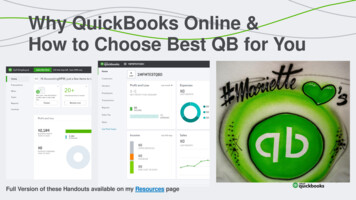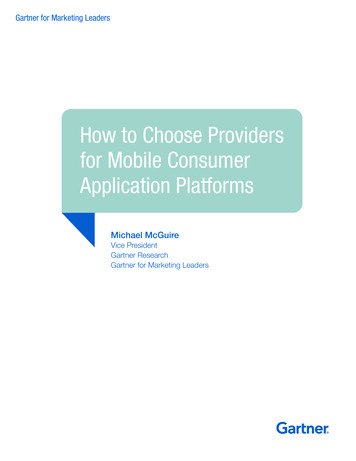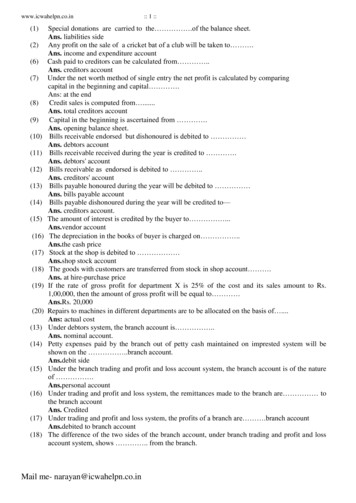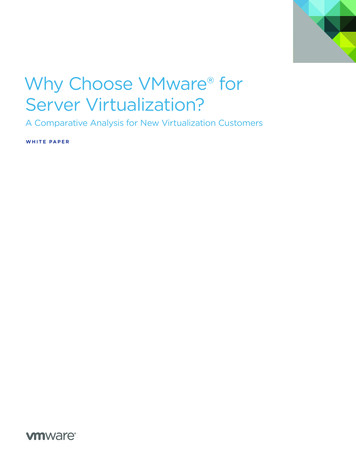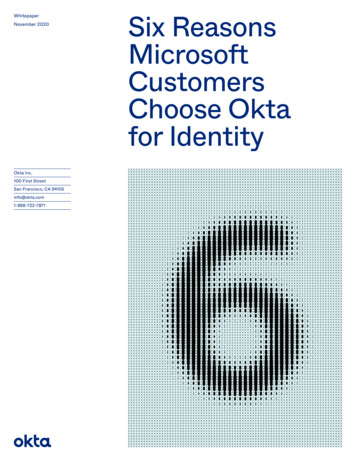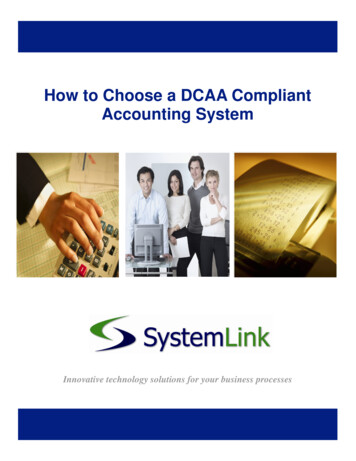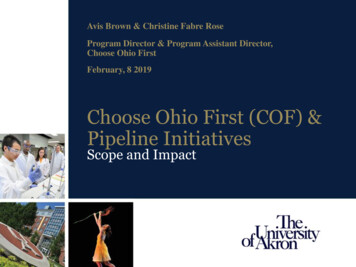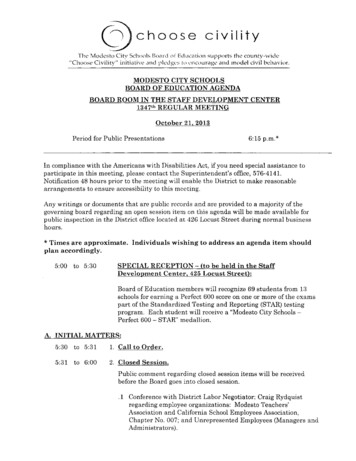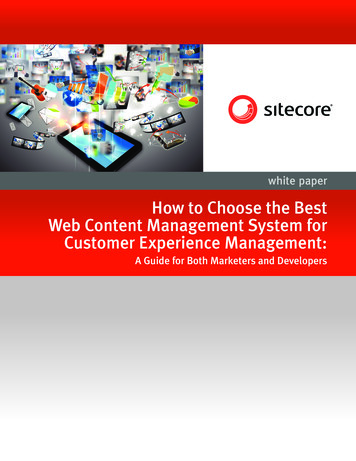
Transcription
white paperHow to Choose the BestWeb Content Management System forCustomer Experience Management:A Guide for Both Marketers and Developers
How to Choose the Best Web Content Management Systemfor Customer Experience ManagementTable of ContentsChoosing a Web CMS is about more than Content Management1The New Requirements for Today’s Web CMS2From the Marketer’s Perspective: Important Capabilities for Your Web CMS3From the Developer’s Perspective: Important Capabilities for Your Web CMS5A Roadmap for Choosing Your CMS7More ResourcesCopyrightCopyright 2013 Sitecore. All Rights Reserved.Restricted Rights LegendThis document may not, in whole or in part, be photocopied, reproduced, translated, or reduced to any electronic mediumor machine readable form without prior consent, in writing, from Sitecore. Information in this document is subject tochange without notice and does not represent a commitment on the part of Sitecore.TrademarksSitecore is a registered trademark of Sitecore. All other company and product names are trademarks of their respectiveowners.
How to Choose the Best Web Content Management Systemfor Customer Experience ManagementChoosing a Web CMS is about more than Content ManagementWe’ve come a long way since the days when a content management system (CMS) was simply a way tomanage and update the content on your website. Today, a web CMS is just one type of technology you need toconsistently deliver an excellent customer experience. While your web CMS is a crucial component, today youmust look at it as part of a larger customer experience management capability.Why the shift? It all starts with the connected, empowered customer who brings greater expectations andpreferences about how and when he or she wishes to engage with a brand. Today’s customers expect aseamless, multichannel experience that anticipates their needs and wants. Companies that deliver this type ofexperience are building trust and loyalty that result in top- and bottom-line improvements including: greaterreturn on marketing investment, increased conversions, higher revenues, and greater lifetime customer value.To achieve these business outcomes, companies are embracing the discipline of customer experiencemanagement and investing in the technology that enables it. A customer experience management platformlets you drive consistency in the experiences that your customers have with your brand. And that’s where aweb CMS comes in. A web CMS helps you achieve that consistency and deliver great web experiences. Therest of the customer experience management solution helps you deliver that content and consistency in otherchannels such as email and social.Because your web CMS must interoperate seamlessly with the components of customer experiencemanagement, the CMS decision shouldn’t be made in a vacuum. This paper highlights the criteria – both fromthe marketers’ and the IT/developers’ perspective – that today’s organizations should consider when selectinga new web CMS as part of a broader customer experience management strategy.“ It is time to start thinking about WCM [web content management] beyond just managingcontent or siloed websites or experiences. Instead, we need to think of how WCM will interactand integrate with other solutions – like search, recommendations, eCommerce, and analytics– in the customer experience management (CXM) ecosystem in order to enable businesses tomanage experiences across customer touchpoints.”— Stephen Powers, Forrester1. “The Emergence of CXM Solutions, and Why the Term ‘WCM’ Lives On,” Stephen Powers, Forrester, August 18, 20111
How to Choose the Best Web Content Management Systemfor Customer Experience ManagementThe New Requirements for Today’s Web CMSOne of the hallmarks of customer experience management is delivering a consistent experience across alltouch points. That’s difficult to achieve if your content management capabilities are isolated in a siloedsystem. Instead, your web CMS needs to integrate and interoperate as part of a centralized platform forcustomer experience management.A customer experience management platform unifies channels, campaigns, visitor information, andperformance measurement into one integrated marketing toolset. The web CMS serves as the core ofthe platform, enabling you to create, manage, and deliver the most relevant content for each interactionbased on centralized customer intelligence. And because of this prominent role in delivering andmanaging an excellent multichannel customer experience, your web CMS must be much more robust,scalable, and flexible than ever before.It’s also important to ensure your web CMS can seamlessly integrate with core systems such as yourcustomer relationship management (CRM) software, ad-serving software, video streaming application,and any other system that would benefit from sharing customer data across the enterprise. Centralizingand sharing customer data enables sophisticated personalization and targeting to deliver a more tailored,relevant experience, which improves customer engagement.Now that we’ve set the context for the importance of the web CMS for customer experience management,let’s take a closer look at the requirements you’ll want to consider when choosing the best web CMS foryour organization.“ WCM products have to work with a wider range of systems — analytic applications,e-commerce platforms, database management systems and so on. As a result of these trends,many IT leaders have to upgrade or replace older WCM systems with new technology that canhandle more complex and critical tasks.”– “Magic Quadrant for WebContent Management,” Gartner,September 6, 20122
How to Choose the Best Web Content Management Systemfor Customer Experience ManagementFrom the Marketer’s Perspective:Important Capabilities for Your Web CMSToday’s marketers require a web CMS which offers far more than simplymanaging content. Ensuring an excellent customer experience calls for a setof capabilities that range from enabling you to deliver powerful interactivefeatures to engage customers on your website, to collecting and utilizingcustomer behavior for personalized interactions, to displaying contentoptimized for mobile devices.The following criteria take these and other requirements into considerationand can be used as a starting point for the marketing team’s evaluation of apotential new web CMS: Easy-to-use interface: This remains a must-have for any web CMS. An intuitive, easy-to-use interfaceenables both marketers and content editors to add and edit online content quickly without having to knowHTML. Casual users should be able to complete routine workflow tasks quickly and easily, while power userscan utilize a more robust interface and set of functionality. Single view of the customer: Look for a web CMS that collects and utilizes visitor information topersonalize the experience. The web CMS should capture information and insights about customers andprospects and combine this information with customer intelligence from other systems such as yourcustomer relationship management (CRM) system for a single, comprehensive view of the customer. Email and automation: The web CMS should integrate email campaign management, testing, andoptimization to maximize campaign and site performance, drive higher conversion rates, and improvemarketing return on investment. Look for marketing automation capabilities that help you eliminaterepetitive tasks and streamline your marketing efforts around everything from email campaigns to landingpages, lead scoring, segmentation and profiling, and testing and optimization. Real-time personalization and targeting: With a single view of the customer, your web CMS shouldbe able to automatically sense and adapt to customer behavior to offer the most relevant content andinteractions. Look for features such as native content profiling to help capture insight into customer needsand interests. Search engine optimization (SEO): The web CMS should integrate SEO with the publishing processso that keyword-rich content and metadata, search-friendly URLs, and other SEO tactics are consistently andautomatically implemented.3
How to Choose the Best Web Content Management Systemfor Customer Experience Management Multilingual support and translation: If your organization has or will have international sites,multilingual and translation support should be on your requirements list. The web CMS should nativelysupport content and websites in multiple languages as well as provide content editing tools that “speak”the major global languages your local, in-country marketing teams use. Also look for a web CMS that easilyintegrates with professional translation services to streamline the process of translating and publishingmultilingual content. Social media support: Any web CMS you choose should include a strong social media component,enabling you to easily create branded communities as well as deliver a seamless experience with thirdparty social networks. The right CMS should make it easy to establish—and maintain—a dialogue withyour customers through blogs, forums, polls, and integration with social media sites such as Facebook andTwitter. Mobile device support: Your web CMS should serve up a consistent, compelling experience on virtuallyany device. Look for a solution that automatically detects the visitor’s device type and optimizes the contentfor the specific device without having to re-render the site for each variation. Multichannel support: Insist on a web CMS that delivers multichannel support and integration includingweb, mobile, email, and social. The right CMS should enable you to view all your channels as a singleexperience and a seamless conversation with the customer, letting you orchestrate, monitor, and measurecustomer interactions across channels. Flexibility to connect with other business applications: Insist on the ability to easily integrateany and all of your line-of-business applications such as customer databases and CRM and ERP systems.Look for prebuilt integration with leading enterprise software packages. You should also look for the ability toconnect to databases and web services without complex programming. Adaptive to future experience and site design improvements: Pick a web CMS that allows youto change design and experience elements without IT effort. You’ll want to be able to update page layouts,add pages, and alter designs all without coding.Think Beyond TodayWhen you create your list of required capabilities, be sure to consider what your organization’sneeds might be in the longer term. For instance, is your company planning to expand to newregions in the next few years? That could mean multisite and multilingual capabilities suddenlybecome must-haves. Or maybe you’re predicting explosive growth in e-commerce and need toensure your solution can rapidly scale. The point is to keep future requirements in mind as well asyou’re going through the evaluation process.4
How to Choose the Best Web Content Management Systemfor Customer Experience ManagementFrom the Developer’s Perspective:Important Capabilities for Your Web CMSWhile marketing decision makers are focused on the CMS capabilitiesthat help optimize the customer experience, developers and IT decisionmakers should evaluate solutions based on the underlying infrastructure,development tools, and other features and capabilities that ensureperformance, flexibility, scalability and ease of use for developers.Here’s a checklist of critical aspects for developers and IT to consider whenevaluating a new web CMS: Developer productivity: Look for a CMS that streamlines development and maintenance with easy-touse tools, controls, and capabilities. Your web CMS should enable you to work with the tools you’re alreadyfamiliar with, such as Microsoft Visual Studio, to make the best use of existing skills. Roles and administration: A good web CMS will provide a sophisticated permission managementsystem that allows you to grant rights to users, groups, and roles for ease of administration and control. Integration: Look for a solution that includes pre-built integration with leading enterprise software,including the ability to connect to databases and web services without complex programming. Design flexibility/customization: The web CMS should be flexible and easily customizable, with toolsthat let designers create and update site experiences without coding. Security: In addition to a permission management system for granting rights to users, groups, and roles,your web CMS should also support external authentication and authorization systems like Active Directorywithout requiring extensive coding and integration efforts. Scalability and performance: It’s essential to understand the performance and scalability implicationsof any web CMS you’re considering. To keep maintenance and ownership costs low, choose a solution thatwill let you deploy multiple websites on a single system. And for greater scalability, choose a web CMS thatcan leverage the cloud infrastructure to rapidly deploy and scale servers to handle increased website trafficand enter new markets—without requiring additional investments in hardware.5
How to Choose the Best Web Content Management Systemfor Customer Experience Management Support for responsive design and mobile devices: Look for native support for multi-deviceoutput, with features such as device previews to enable optimization of content, site layouts, and renderings.The web CMS should automatically detect the visitor’s device type and serve optimized content for thatdevice. Multisite and multilingual support: Select a web CMS that supports any number of domainsmapping to different web properties, as well as flexible sharing of content and code between sites. Ensurethat the solution enables many-to-many language support to avoid creation of extensive new data structureswhen supporting different languages. Technical support and training: Evaluate the breadth and depth of the vendor’s support and trainingofferings to make sure they deliver the level of support and education your organization has come to expect.Be on the Lookout for Bloated SolutionsIn selecting a web CMS as part of a customer experience management solution, avoid choosing aCMS that includes loads of features your organization may never use. In other words, look for the“best of need” solution with everything that you do need and very little of what you don’t need.This will help keep the complexity down, while ensuring the solution you do pick is best suited toyour requirements.6
How to Choose the Best Web Content Management Systemfor Customer Experience ManagementA Roadmap for Choosing Your CMSOnce you have your own list of important marketing and technical capabilities for a new web CMS, then you cancreate a short list of potential solutions that meet your needs. Once you have a short list, you’ll need to put oneor more web CMSs to the test to see which one bests suits your organization’s needs.The following best practices provide some guidance on how to gather hands-on experience, third-partyobjective information, and product know-how to inform your decision. Think of it as a roadmap for choosingyour new web CMS:1Bring marketing and IT together: The entire team, including marketing, content editors,developers, and designers should participate in comprehensive demonstrations. While theinitial meeting includes the entire team, allow different groups ample time to have their ownsessions with the CMS vendor where they can ask questions, at their level, that address theirbusiness or technical requirements.2Try it before you buy it: Request that the CMS vendor install a clean/out-of-the-box versionof its product for your development team. Demo systems are highly configured and don’tnecessarily give you a clear view of the complexity of the product. With a clean installation,your organization can see how easy or difficult it is to get started.3See it in action: Ask the web CMS vendor to build a simple website from scratch for yourdevelopment team. This will reveal what functionality ships with the product, as distinct fromcustomizations that may have been included in the demo system.4Attend vendor training: Strongly consider sending your developers to the web CMS vendor’stechnical training class. They will gain a clearer perspective of the product’s capabilities andshortcomings, potentially saving your organization significant time and money in the long run.5Tap the developer community: Determine if there is a vibrant developer community around theCMS you’re considering and then tap into it for further insight into the product.6Talk to other customers: Ask the vendor for references of customers in your industry. Speakwith those customers to gain insight into real-life experiences with the product.Finally, if your budget allows, or if you already retain their services in your organization, ask an analyst witha leading firm such as Gartner or Forrester to provide insight into web CMS vendors. As renowned advisoryservices for technology and its implementation, these firms can help you understand which solutions areappropriate for your business requirements.7
How to Choose the Best Web Content Management Systemfor Customer Experience ManagementMore ResourcesMarketing Marketing.aspxSuccess Factors for ess Factors for tive.aspxSuccess Factors for -Factors-for-IT-for-CMS-Selection.aspxAbout SitecoreSitecore is a global software company that creates products to deliver the most relevant experience and contentto customers at any moment of interaction and via any communications channel – the web, email, mobile,social and offline. Our customer experience management platform combines proven web content managementwith customer intelligence to create a single view of a customer that drives meaningful interactions, increasesconversions and builds lifetime customers. Global brands, including American Express, Carnival Cruise Lines,easyJet, Heineken, LEGO, Microsoft, and Nestle rely on Sitecore to get and keep loyal customers who engagemore and drive revenue growth.For more information about Sitecore, visit www.sitecore.net.8
One of the hallmarks of customer experience management is delivering a consistent experience across all touch points. That’s difficult to achieve if your content management capabilities are isolated in a siloed system. Instead, your web CMS needs to integrate and interoperate as part of a centralized platform for customer experience management.
